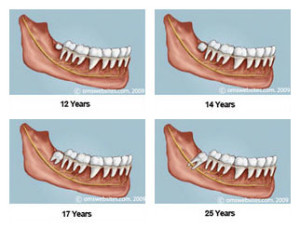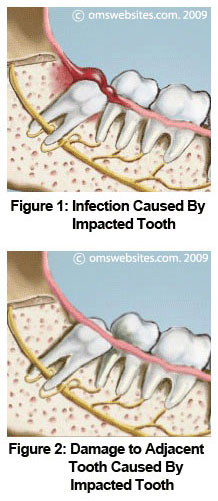183 Genesee Street
Auburn, NY 13021
Wisdom Teeth

By the age of eighteen, the average adult has 32 teeth; 16 teeth on top and 16 teeth on the bottom. Each tooth in the mouth has a specific name and function. The teeth in the front of the mouth (incisors, canine, and bicuspid teeth) are ideal for grasping and biting into smaller pieces. The back teeth or molars are used to grind food up into a consistency suitable for swallowing.
The average mouth is made to hold only 28 teeth. It can be painful when 32 teeth try to fit in a mouth that holds only 28 teeth. These four other teeth are your Third Molars, also known as “Wisdom Teeth”. Normally a person will develop four wisdom teeth, but some people may have more or less.
When and Why Should My Wisdom Teeth Be Removed?
A tooth becomes impacted because there is a lack of space in the dental arch, causing the tooth to grow on an angle towards the other molars and their roots. This impaction can cause pain, lead to infection, or cause other pathologic conditions (See Figure 1).
The wisdom tooth may also crowd or damage the adjacent molar and its roots (See Figure 2), or damage the jaw bone and its nerves. When the wisdom tooth is growing toward adjacent teeth, it can trap plaque and debris making your teeth more vulnerable to decay.
Wisdom teeth will likely cause problems as the patient ages. We recommend that children in their mid-teen years receive an evaluation by a dentist, orthodontist, or oral and maxillofacial surgeon to determine the location and condition of wisdom teeth. Early intervention to remove wisdom teeth can prevent future discomfort, promote rapid healing, and pave the way for a healthy smile. Wisdom tooth removal also aids in orthodontic treatment by creating space in which permanent teeth can emerge or be moved into their ideal arrangement.
What Does Removing My Wisdom Teeth Require?
 The ease of the wisdom teeth removal depends on the position of the tooth and root development. During your consultation visit, we will take X-rays that will reveal the position of the tooth, its length, and shape. A wisdom tooth that has fully cut through the gum can be extracted much like any other tooth.
The ease of the wisdom teeth removal depends on the position of the tooth and root development. During your consultation visit, we will take X-rays that will reveal the position of the tooth, its length, and shape. A wisdom tooth that has fully cut through the gum can be extracted much like any other tooth.
A wisdom tooth that is underneath the gums and pushed into the jawbone will require an incision into the gums and removal of the portion of bone that lies over the tooth. In this case, the tooth will be extracted in smaller portions to minimize the amount of bone that is removed.
In most cases, the removal of wisdom teeth is performed under intravenous sedation. The anesthesia options as well as the surgical risks (i.e. sensory nerve damage, sinus complications), will be discussed with you during your consultation appointment.
What Can I Expect After an Extraction?
In order to prevent infection following your extraction, it is very important to keep the area clean. For the first 24 hours following the surgery, you should avoid cleaning the teeth adjacent to the extraction site, refrain from smoking or rinsing your mouth vigorously. You may experience discomfort following an extraction. Upon discharge, your postoperative kit contains a prescription for pain medications, possibly antibiotics, extra gauze and if supplied, a syringe that can be used on the fourth (4th) day after surgery to clean the lower extraction sites.




